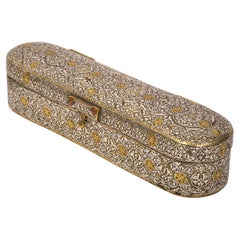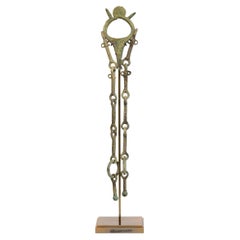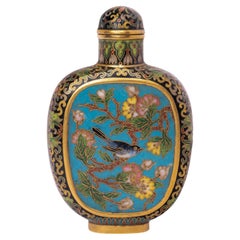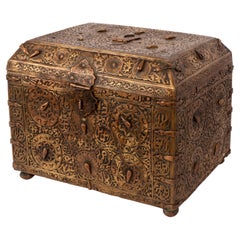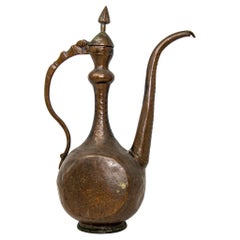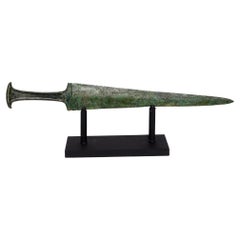18th Century and Earlier Metalwork
to
15
80
35
126
3
2
126
879
845
27
441
182
56
40
12
20
8
10
8
23
10
5
1
125
77
15
14
13
118
80
43
28
22
126
126
126
Period: 18th Century and Earlier
Antique Islamic 15th Century Mamluk Qalamdan Gold Silver Inlaid Brass Pen Box
Located in Portland, OR
A fine and important late 15th century Mamluk period inlaid penbox (Qalamdan), possibly Syria or Mosul, late 1400's.
The slightly domed penbox is lavishly inlaid with gold and silver...
Category
Syrian Islamic Antique 18th Century and Earlier Metalwork
Materials
Gold, Silver, Brass
$15,000 Sale Price
25% Off
500 B.C., Dong Son, Antique Khmer Bronze Bangle Bracelet with Bell
Located in Sampantawong, TH
Dong Son bronze bracelet with bell, very nice green patina.
Age: Cambodia, Dong Son Period, 500 B.C.
Size: width 8 cm / length 43.4 cm.
Size including stand: height 49.5 cm.
Co...
Category
Cambodian Antique 18th Century and Earlier Metalwork
Materials
Bronze
$1,200 Sale Price
20% Off
Antique 16k Gold Chinese Qianlong Cloisonne Enamel Snuff Bottle Mark & Period
Located in Portland, OR
A fine & rare antique Imperial Chinese Qing dynasty solid gold & cloisonne enamel snuff bottle, Qianlong mark & period, 1736-1795, tests as 16k gold.
It is rare to find a cloisonné e...
Category
Chinese Qing Antique 18th Century and Earlier Metalwork
Materials
Gold, Enamel
Antique 16th Century Islamic Safavid Al Jazari Combination Locking Brass Casket
Located in Portland, OR
A highly important engraved Islamic combination locking brass casket, based on a design by the 12th Century Arab inventor & artist Ismail Al Jazari. Circa...
Category
Iraqi Islamic Antique 18th Century and Earlier Metalwork
Materials
Brass
$24,500 Sale Price
30% Off
Antique Islamic Middle Eastern Qajar Persian Copper Ewer 19th Century
Located in North Hollywood, CA
Antique Islamic Middle Eastern Qajar Persian Copper Ewer 19th Century.
Rare Museum quality Antique piece from the early 19th Century hand forged copper pitcher with lid cover.
Great antique patina.
Circa 1800.
Measurements: 14” height 9.5” length 5” width.
Quality Museum Islamic Metalwork from a private Beverly Hills CA collection.
Middle Eastern Asian Turkish Ottoman Antique...
Category
Unknown Islamic Antique 18th Century and Earlier Metalwork
Materials
Copper
Western Asiatc Luristan Bronze Dagger
Located in Dallas, TX
2000-700 BC. Luristan (Louiristan) Culture. Bronze dagger with a bevelled leaf-shaped blade and wrap-around handle culminating in an oval-shaped pommel. The handle would originally h...
Category
Persian Archaistic Antique 18th Century and Earlier Metalwork
Materials
Iron
Dong Son Culture Ritual Bronze Drum, 4th-3rd Century BC, Vietnam
Located in Austin, TX
A well cast and intricately decorated bronze drum from the Dong Son culture, circa 4th - 3rd century BC, Red River Delta, Vietnam.
The face of the drum features a central 8 pointed...
Category
Vietnamese Antique 18th Century and Earlier Metalwork
Materials
Bronze
Chinese Western Han Dynasty Bronze Garlic Head Vase, 206 BC - 25 AD
Located in Austin, TX
A rare and attractive Chinese bronze "garlic head" vase with an encrusted patina, Western Han Dynasty, 206 BC - 25 AD, China.
Of classic form, the bronze vase is set on a short, s...
Category
Chinese Han Antique 18th Century and Earlier Metalwork
Materials
Bronze
Antique Edo Period Japanese Samurai Iron Stirrups with Brass or Bronze Inlay
Located in Centennial, CO
A pair of antique Edo period (1603–1867) Japanese Samurai Abumis (stirrups for horseback-riding) expertly crafted out of cast iron with brass or bronze inlay in the form of a stylize...
Category
Japanese Edo Antique 18th Century and Earlier Metalwork
Materials
Brass, Bronze, Iron
Large Rare Antique Japanese Cloisonne Enamel Plate
Located in Long Island City, NY
A large rare antique, Meiji era, Japanese enamel over copper plate or charger. The interior of the plate is adorned with a polychrome enamel image of blossoming flowers surrounded by...
Category
Japanese Meiji Antique 18th Century and Earlier Metalwork
Materials
Copper, Enamel
Khmer Bronze Hairpin
Located in Vosselaar, BE
Elegant and refined Khmer bronze hairpin dating between the 12th and 15th century.
Category
Cambodian Antique 18th Century and Earlier Metalwork
Materials
Bronze
A Momonari-type samurai Kabuto with menpō mask
Located in Milano, IT
A Kabuto Momonari-type samurai helmet, so named because of its characteristic shape resembling a peach, made of natural iron.
The visor (mabizashi) is embellished with raised eyebr...
Category
Japanese Antique 18th Century and Earlier Metalwork
Materials
Iron
$13,515 Sale Price
20% Off
Antique Dutch Colonial VOC Batavian Tortoise Shell Silver Sirih Casket 1750
Located in Portland, OR
A rare, Dutch Colonial, Batavian (now Jakarta) Dutch East Indies silver and tortoise shell Sirih casket, circa 1750.
The casket was used for storing highly prized betel nut, which was chewed ritually by high ranking Indonesian officials and adopted by settlers from the Dutch East Indies Company...
Category
Indonesian Dutch Colonial Antique 18th Century and Earlier Metalwork
Materials
Silver
$5,200 Sale Price
20% Off
19th Century Japanese Bronze Vase
Located in Stamford, CT
19th century Japanese bronze vase of classic form with a lovely rich patina. The vase has been drilled for wiring as a lamp. It will make ...
Category
Japanese Japonisme Antique 18th Century and Earlier Metalwork
Materials
Bronze
Antique Meiji Era Japanese Cloisonne Enamel Plate
Located in Long Island City, NY
An antique Japanese, Meiji era, enamel plate or charger. The interior of the plate is adorned with a polychrome enamel image of a butterflies, blossoming flowers surrounded by tradit...
Category
Japanese Meiji Antique 18th Century and Earlier Metalwork
Materials
Brass, Enamel
Chinese Ming Dynasty Silver Nine Phoenix Coronet Crown, 16th/17th Century
Located in Austin, TX
An amazing and rare Chinese silver Nine Phoenix Coronet or Crown, Ming Dynasty (1368 to 1644), late 16th to early 17th century, China.
A delicate and...
Category
Chinese Antique 18th Century and Earlier Metalwork
Materials
Silver, Gold
Qianlong period Canton Enamel Square Dish with Dragon, China Late 18th Century
Located in Grythyttan, SE
This small and exquisite Chinese Canton Qianlong period enamel square dish features cut corners and is beautifully decorated with a five-clawed pink dragon surrounded by 18 blue ruyi clouds against a vibrant yellow background. The design is accented by two branches of peaches (or similar fruit) and two branches of peach blossoms (or other fruit blossoms), all framed by an intricate seaweed pattern border.
In Chinese symbolism, five-clawed dragons are reserved exclusively for emperors, as the number five is considered sacred, representing the five elements. In contrast, four-clawed dragons are associated with kings, princes, and high-ranking officials, while three-clawed dragons are designated for the merchant class.
This piece is crafted from enamel on brass, dating back to the Qianlong period (1736–1795), and is characterized by its hexagonal form and the distinctive Famille Rose palette, often referred to as "Canton enamel."
Chinese painted enamel, commonly known as Canton enamel, derives its name from its principal manufacturing location, Canton. This technique was introduced to China in the 18th century, likely by French missionaries, and is inspired by the enameling techniques developed in Limoges, France around 1470. It is referred to in China as "foreign porcelain," suitable since much of it was made for export.
During the 18th and 19th centuries, there was significant demand in the West for Chinese porcelain dinner sets...
Category
Chinese Qing Antique 18th Century and Earlier Metalwork
Materials
Copper, Enamel
Large Chinese Archaistic Black Patina Bronze Altar Vase
Located in Mt Kisco, NY
Chinese bronze vase with decoration in the Archaistic style and dragon mythical beast loop handles.
Category
Chinese Archaistic Antique 18th Century and Earlier Metalwork
Materials
Bronze
Edo Period Chain Mail Armor Jacket, Kusari or Karuta, Japan
Located in Point Richmond, CA
Edo period Chain Mail Armor Jacket, Kusari or sometimes known as Karuta, Japan
Japanese chain mail armor jacket is composed of brass metal plates linked together with metal wires an...
Category
Japanese Edo Antique 18th Century and Earlier Metalwork
Materials
Brass
$2,800 Sale Price
20% Off
Archaic Chinese Bronze Ritual Vessel, Gui, Early Western Zhou, 11th century BCE
Located in Austin, TX
A stunning and rare Chinese archaic bronze gui, a type of ritual bronze vessel used to hold grain, either for feasting, or for making offerings ...
Category
Chinese Archaistic Antique 18th Century and Earlier Metalwork
Materials
Bronze
Small Burmese Karen 4 Frog Drum, 18th century
Located in Point Richmond, CA
Burmese Karen Frog Drum, a small bronze tribute drum (Heger Type III), Pazi (Burmese), pam klo’ (Karen) also known as “The Magical Bronze Pond” (Cooler - ...
Category
Burmese Tribal Antique 18th Century and Earlier Metalwork
Materials
Bronze
A Very Rare Pair Chinese Kangxi Period Cloisonné Planters w/ Landscape Scene
Located in New York, NY
An Extremely Rare Pair of Chinese Kangxi Period Cloisonné Planters with Landscape Scene. These vessels are formed in deep bowl shapes with recessed, gilt-lined rims and short, slight...
Category
Chinese Qing Antique 18th Century and Earlier Metalwork
Materials
Bronze
Antique Chinese Cloisonné Enamel Gu Form Vase, 17th/18th Century, Kangxi Period
Located in New York, NY
A Fantastic, rare, and antique Chinese Cloisonné Enamel Gu Form vase, 17th/18th century, Kangxi Period. This cloisonne vase is extremely rare to find in this quality, condition, age,...
Category
Chinese Qing Antique 18th Century and Earlier Metalwork
Materials
Bronze
A Ming Dynasty Patinated Bronze Relief Work Vase Turned to a Lamp
Located in New York, NY
Hailing from the Ming period in 16/17th century, this monumental bronze vase is a fine example of the auspicious decor and markings unique to Chinese furnishings. The vase is cast wi...
Category
Chinese Ming Antique 18th Century and Earlier Metalwork
Materials
Bronze
Antique 19th C Hindu Shiva Brass Votive Head Indian Ritual Art Sculpture
Located in London, GB
Antique Indian Hindu Shiva Brass Votive Head – 19th Century
Beautiful 19th-century brass votive head of Lord Shiva, finely cast with detailed moustache and turban. This larger form ...
Category
Indian Antique 18th Century and Earlier Metalwork
Materials
Brass, Bronze
Khmer Bronze Two Part Bottle Vase, Angkor Period, 12th-14th Century
Located in Austin, TX
An elegant Khmer pear shaped bronze bottle vase, Angkor Period, 12th-14th century.
Crafted of bronze in two parts. When separated, the lower portion of the vase becomes an offerin...
Category
Cambodian Antique 18th Century and Earlier Metalwork
Materials
Bronze
Ancient Gandharan Large Bronze Figural Seated Buddha Tsatsa Casting Mold
Located in Philadelphia, PA
A fine ancient Gandharan Tsa Tsa mold.
In the form of the Buddha seated in meditation.
With a handle to the base of the front.
With verdigris throughout and mounted on a rectangul...
Category
Indian Antique 18th Century and Earlier Metalwork
Materials
Bronze
Antique Asian Cast Bronze Buddha Head Fragment Bust Sculpture Thai, 18th Century
Located in Hamilton, Ontario
Antique Asian and extremely detailed cast bronze fragment of the head of Buddha, dating from the 18 century and presumably having Thai or Tibetan origins. The sculpture fragment is s...
Category
Thai Tibetan Antique 18th Century and Earlier Metalwork
Materials
Bronze
Large Himalayan Inlaid Bronze Vajra with Wrathful Faces, 15th-16th Century
Located in Austin, TX
A large and unusual Himalayan bronze and mixed metal nine prong vajra featuring wrathful faces. In the style of the Tangut (Western Xia) Kingdom (1038 to 1227), but probably later, most likely 15th-16th century.
The body of the vajra crafted from a copper alloy, with five wrathful faces on either side and gold and silver inlays to the center. The prongs crafted of iron, with each side having eight prongs arcing outwards around a central prong before coming back to a copper alloy point.
The vajra is meditational tool...
Category
Mongolian Antique 18th Century and Earlier Metalwork
Materials
Iron, Gold, Silver, Bronze
Pair of Korean Goryeo Dynasty Bronze Pedestal Bowls, 13th-15th Century, Korea
Located in Austin, TX
An exquisite pair of Korean bronze pedestal offering bowls, Goryeo Dynasty, 13th-15th century, Korea.
The Goryeo bronze bowls of generous proportions, with high sides and an ever so slightly everted rim. The bowls are supported on a pedestal base with a tall stem and wide, splayed ring foot.
The bowls plain, save for a single engraved line circumscribing the splayed foot.
The bowls with an amazingly rich and complex patina of mottled reddish browns from cuprite and dark greens from malachite. The bronze heavily cleaned to the European taste, removing most of the encrustations. Some areas of the bowls with rougher areas where the accretions could not be removed.
Crafted in two parts in the spun bronze technique, then joined. The bowls are unusually thin for bronze, with the lathe lines still visible to the undersides.
An unusual form and size for Goryeo period bronze utensils...
Category
Korean Antique 18th Century and Earlier Metalwork
Materials
Bronze
Small Japanese copper vase made in the late Edo period / 1750-1868 / Flower vase
Located in Sammu-shi, Chiba
This is a copper vase made around the late Edo period.
The body is cast.
This is a vase for holding flowers to be offered in a tokonoma alcove or in front of a Buddha.
The tip is sha...
Category
Japanese Edo Antique 18th Century and Earlier Metalwork
Materials
Copper
Chinese Bronze Dragon Vase with Arrow Handles, Qing Dynasty, 18th Century, China
Located in Austin, TX
A well cast and powerful Chinese dragon bronze altar vase with arrow handles, Qing Dynasty, 18th century or earlier, China.
The altar vase of bottle form, set on a high, splayed r...
Category
Chinese Qing Antique 18th Century and Earlier Metalwork
Materials
Bronze
Large Dong Son Culture Ritual Bronze Bell
Located in Austin, TX
A large and finely cast ritual bronze bell from the Dong Son Culture (circa 1000 BC-200 AD).
Of unusually large size, the thinness of the bronze speaks to the advanced techniques ...
Category
Vietnamese Antique 18th Century and Earlier Metalwork
Materials
Bronze
Quality antique George III copper cooking pot
Located in Ipswich, GB
Quality antique George III copper cooking pot, having a iron swing handle and a removable copper lid, to the front PCN stamped 1770.
D. 1770
Category
George III Antique 18th Century and Earlier Metalwork
Materials
Copper
Chinese Qing "Goose" Cloisonné Bronze Wine Ewer
Located in Kastrup, DK
A Chinese wine wessel crafted in dark-patinated bronze, shaped as an elegant goose with a gracefully curved neck.
The ewer is adorned with high-quality cloisonné work, featuring inla...
Category
Chinese Qing Antique 18th Century and Earlier Metalwork
Materials
Bronze, Enamel
Antique Japanese Patinated Bronze Buddhistic Lion Censer 17th/18th Century
Located in Forney, TX
A remarkable Edo Period (1603-1868) Japanese patinated bronze Buddhistic lion censer, exceptionally executed sculptural shishi foo dog form, finely detailed, retaining the original r...
Category
Japanese Edo Antique 18th Century and Earlier Metalwork
Materials
Bronze
Splendid and Heavy Late 17th Century Dutch-Colonial Silver Filigree Salver
Located in Amsterdam, NL
A splendid and heavy Dutch-colonial silver filigree salver
Indonesia, Batavia (Jakarta) or possibly Padang, West Sumatra, 2nd half 17th century
Diam. 22.9 cm
Weight 551 grams
This filigree-work was probably done by Chinese masters...
Category
Indonesian Dutch Colonial Antique 18th Century and Earlier Metalwork
Materials
Silver
Very Exceptional Almost Identical Pair of Bronze Buddhas
Located in Schellebelle, BE
Two bronze Buddhas, Ayutthaya, 16th century, Thailand
with great patina
dimensions
26 cm X 13 cm X 8 cm
24 cm X 14 cm X 8 cm.
Category
Antique 18th Century and Earlier Metalwork
Materials
Bronze
Ming Dynasty Period Cast Bronze Hue Shaped Urn in an Archaist Style
Located in Hudson, NY
This fine old urn cast as an honorific nod to the ancient past of China was made circa 1600-1650. The shape or Hue was a common and well-represented form in the Han dynasty in pottery and bronze. This urn shows thin casting to the walls with incorporated toe tia or facial masks...
Category
Chinese Ming Antique 18th Century and Earlier Metalwork
Materials
Bronze
12-14th century Sukhothai kingdom(Thailand) rare bronze ribbed bowl
Located in Fukuoka, JP
Extremely rare ribbed offering bowl. Bronze with beautiful natural patination, excellent example of Sukhothai religious art.
Part of the private Japanese collection.
Material: Bro...
Category
Thai Antique 18th Century and Earlier Metalwork
Materials
Bronze
China 960 Ad Song Dynasty Very Rare Imperial Period Offering Vessel in Bronze
Located in Miami, FL
Offering vessel from the Chinese Song Dynasty (960/1279 AD ).
A beautiful "offering spiritual vessel" from the Yunnan province region in the ancient China. This rare vessel was created in red bronze during the Song Dynasty period. between 960/1279 AD.
This is one of the most unusual forms of red bronze jar. A large vessel, the sides are virtually perpendicular to the base. The stepped lid design is also among the more rare types. The predominant lid design among the Yunnan offering bronzes is the "wheel" pattern, with a few lids having the lotus design. This is also one of the few bronzes displaying clear riveting of a two-part vessel body, with the original twisted elements
Has a combined measures including the lid of 12.5 by 8.75 inches (31.75 x 22,23 Cm).
The Song Dynasty, was an imperial dynasty of China that began in 960 and lasted until 1279. The dynasty was founded by Emperor Tizu of Song following his usurpation of the throne of the later Zhou, ending the Five-Dynasties and Ten Kingdoms period. The Song often came into conflict with the contemporaneous Liao, Western Xia and Jin dynasties in northern China. After decades of armed resistance defending southern China, it was eventually conquered by the Mongol-led Yuan dynasty.
The dynasty is divided into two periods: Northern Song and Southern Song...
Category
Chinese Medieval Antique 18th Century and Earlier Metalwork
Materials
Bronze
$3,960 Sale Price
20% Off
Chinese bronze sacrificial vessel, or Fangding
Located in Castle Douglas, GB
Chinese bronze sacrificial vessel, or Fangding
A ding of rectangular form and upon four cylindrical legs. A loop handle to each end and flanges to each corner and side. The ding is cast in relief on all four sides with a taotie mask, with a leiwen ground, the thunder motif depicted by juxtaposed square spirals. Above each taotie mask there are depicted kui dragons. A collar to the upper section of each leg further decorated with kui and leiwen, the collar with a flange to the outside edge. The bronze of dark colour with chocolate brown highlights.
Most ding vessels...
Category
Chinese Antique 18th Century and Earlier Metalwork
Materials
Bronze
12th Century, Angkor Vat, A Pair of Antique Khmer Bronze Hand Bells with Stand
Located in Sampantawong, TH
A pair of Khmer bronze hand bells with very nice patina.
Age: Cambodia, Angkor Vat Period, 12th Century
Size: Height 12.8 - 14 C.M. / Width 6.5 - 7.8 C.M.
Size including stand: Heig...
Category
Cambodian Antique 18th Century and Earlier Metalwork
Materials
Bronze
$1,072 Sale Price / set
20% Off
Korean Bronze Bottle Goryeo Dynasty
Located in Atlanta, GA
An antique Korean bronze bottle of bulbous pear form with a long neck and flared open mouth from Goryeo Dynasty (918 AD-1392 AD) circa 12-13th century I...
Category
Korean Archaistic Antique 18th Century and Earlier Metalwork
Materials
Bronze
Densatil Gilt Bronze Caryatid Figure, Tibet, 15th Century
Located in Austin, TX
A heavy and solidly cast, richly gilt, bronze caryatid figure from Densatil Monastery, Central Tibet, early 15th century or earlier.
Cast in the form of two four armed figures standing back to back in tribhanga (thrice bent position) on a lotus platform, this piece would originally have served as a pillar for a larger seated deity...
Category
Tibetan Tibetan Antique 18th Century and Earlier Metalwork
Materials
Bronze
18th Century Chinese Qing Bronze Duck Incense Burner Sculpture
Located in Haddonfield, NJ
18th century Chinese bronze duck incense burner, Qing period
Please note that one foot is missing, broken off, see detailed image.
Category
Chinese Qing Antique 18th Century and Earlier Metalwork
Materials
Bronze
$1,000 Sale Price
33% Off
Korean Goryeo Bronze Basin, Goryeo Dynasty, 12th - 14th century, Korea
Located in Austin, TX
A sublime Korean bronze ritual basin with incredible patina, Goryeo Dynasty (918 to 1392 AD), 12th - 14th century, Korea.
The Goryeo bronze basin of shallow bowl form, set on a sho...
Category
Korean Antique 18th Century and Earlier Metalwork
Materials
Bronze
Korean Bronze Bottle Vase, Goryeo Dynasty, 11th/12th Century, Korea
Located in Austin, TX
An attractive Korean Goryeo Dynasty bronze bottle vase with traces of gilding, 11th - 12th century, Korea.
The vase of typical form, with a short recessed foot supporting a pear s...
Category
Korean Antique 18th Century and Earlier Metalwork
Materials
Bronze
Pair of Fine Islamic Silver Filigree Rosewater Sprinklers, Early 18th Century
Located in Amsterdam, NL
A pair of very fine silver filigree rosewater sprinklers
Possibly India, Karimnagar, early 18th century
Height 31.6 cm and 31.7 cm, weight 39...
Category
Indian Islamic Antique 18th Century and Earlier Metalwork
Materials
Silver
Rare Chinese Tonkin Ware Cup-and-Saucer, Early 18th Century
Located in Amsterdam, NL
A Chinese made tonkin ware gilt- and lacquer cup and saucer
China or Japan, Chinese artisans, early 18th century
The black-lacquered cup with gilt handles in the shape of sculptured chrysanthemums and a lobbed edge decorated with gilt engraved border, with a gilt foot-ring that fits into the saucer ring, with two cartouches showing partly undercut gilt relief trees and birds on a gilt granulated background, black lacquered bracket-lobed edge, depicting gilt engraved peony scrolls and three cartouches decorated with high relief gilt trees and birds on a gilt granulated background, the centre with engraved chrysanthemum, enclosed by a raised ring upon which the cup fits, around which a circular panel decorated with high gilt relief trees, flowers, birds and a butterfly on a gilt granulated background.
Measures: Cup: H. 5.7 x W. 8.5 cm
Saucer: Diameter 13 cm
Provenance:
Collection Felix Schäfer
Note:
The decoration of the cup and saucer is identical to the slightly smaller cup and saucer...
Category
Chinese Chinese Export Antique 18th Century and Earlier Metalwork
Materials
Other
Very Late 18th-Early 19th Century Cast Bronze Chinese Archaistic Vessel
Located in Hudson, NY
This Chinese cast bronze urn was made to pay honor to the fine vessels produced in the Shang, Zhou and Han periods. This work cast in the late 18th into the early 19th century (circa...
Category
Chinese Archaistic Antique 18th Century and Earlier Metalwork
Materials
Bronze
Fine Indian Silver Filigree Casket with Hinged Cover, 18th Century
Located in Amsterdam, NL
A pair of very fine silver filigree rosewater sprinklers
Possibly India, Karimnagar, early 18th century
Measures: Height 31.6 cm and 31.7 cm,...
Category
Indian Antique 18th Century and Earlier Metalwork
Materials
Silver
Large Bronze Bell
Located in Schellebelle, BE
Large bronze bell with geometric decorations
South East Asia
Beautiful green patina.
Category
Asian Antique 18th Century and Earlier Metalwork
$4,135
Pair of Rare Edo-Meiji Period Bronze Hibachi with Lion Handles
Located in Fukuoka, JP
This exceptional pair of bronze hibachi (traditional Japanese braziers) dates back to the Edo period and features exquisite craftsmanship with intrica...
Category
Japanese Edo Antique 18th Century and Earlier Metalwork
Materials
Bronze
Rare Chinese Tonkin Ware Shakudo Sawasa Erotic Tobacco Box
Located in Amsterdam, NL
A ruyi-shaped Shakudo-style erotic tobacco or snuff box, relief-decorated with silvered applied figures
Possibly Jakarta (Batavia), first half 18th century
Measures: H. 2.2 x L. 12.1 x W. 8 cm
This box is very much in the Dutch taste, for the illustration is after a print with a legend reading “L’oiseau sans cage. Prenez, belle, mon oiseau. C’est le plus doux présent que je puisse vous faire. Pour les autres oiseaux, la cage d’ordinaire est une espèce de tombeau. Mais le mien semble prendre une nouvelle vie, Lorsqu’il sera dans la cage de mon aimable Silvie.” The erotic message is as clear as can be.
In Dutch culture the verb ‘vogelen’ (catching a bird) is another word for having sex and a bird escaping from his cage indicates loss of chastity. The lady with the bare breasts, while making the sign of sealed lips to the lady behind her, who is pointing towards heaven, seems to be caressing the bird held in the sleeping man’s groin. 17th century Dutch pictures...
Category
Chinese Chinese Export Antique 18th Century and Earlier Metalwork
Materials
Gold, Silver, Bronze
Large Rare Antique Japanese Cloisonne Enamel Plate
Located in Long Island City, NY
A large rare antique, Meiji era, Japanese enamel over copper plate or charger. The interior of the plate is made in a symmetrical design, adorned with polychrome enamel medallions fe...
Category
Japanese Meiji Antique 18th Century and Earlier Metalwork
Materials
Copper, Enamel
Dutch Colonial Silver Dish with the Von Pfeffel Coat-of-arms, 17th Century
Located in Amsterdam, NL
An unusual Indonesian lobbed silver dish
Jakarta (Batavia) or Coromandel coast, third quarter 17th century, apparently unmarked
The eight lobbed dish exuberantly decorated with floral motifs, with the middle section replaced, consisting of indistinctly marked German silver from the early 19th century, bearing the coat-of-arms of the Von Pfeffel family.
Diam. 30.5 cm
Weight 461 grams
Note:
Lobbed silver dishes with exuberant floral decorations were characteristic of the decorative arts in the Netherlands in the first half of the 17th century. This style of floral decoration was adopted by silversmiths as well as by furniture makers working on the Coromandel Coast and in Batavia, often by workers who had fled the Coromandel Coast because of war and famine. In Batavia this style was known as “Custwerck” (work from the Bengal coast).
These lobbed dishes are seldom marked. Only after 1667 the use of the town mark became obligatory in Batavia but only for silver made in Batavia not for silver imported in Batavia from other VOC settlements. The engraved coat of arms in the centre is a replacement of the original centre.
The coat of arms can be identified as those of Christian Hubert von Pfeffel (1765- 1834). As a diplomat, statesman, ambassador of Bavaria in London and Saxony and councillor to the King of Bavaria, he was made “Freiherr” in 1828 and since then used this coat of arms. His son Karl Maximilian Friederich Hubert Freiherr von Pfeffel (1811-1890) in 1836 married Karoline Adelheid Pauline von Rottenburg (1805-1872), the natural daughter of Prins Paul von Württemberg (1785-1852) and his mistress Margrethe Porth. Paul was the jounger brother of the King Wilhelm I of Württemberg (1781-1864). The heraldic motto of the von Pfeffels Vur Schande habe den Huot means as much as “Beware of Shame”. Christian Hubert Theodoor Marie Karl von Pfeffel Karl Maximilian’s grandson was the last male in the von Pfeffel line. His daughter, Marie Louise (Paris in 1882 - Cornwall 1944), born and grown-up in France, changed her name in de Pfeffel. She was the great grandmother of Boris Alexander de Pfeffel Johnson, the present British Secretary of State. None of the members of the von Pfeffel family had any direct links with the Dutch East Indies but indirectly by way of the Royal House of Württemberg they did.
Sophia Frederika Mathilda von Württemberg (1818-1877), daughter of Wilhelm I King of Württemberg, in 1839 married Willem III...
Category
Indonesian Dutch Colonial Antique 18th Century and Earlier Metalwork
Materials
Silver
Chinese Bronze Vessel with Tripod Feet, c. 1750
Located in Chicago, IL
This 18th century bronze vessel with tripod feet was crafted by hand in a traditional Chinese shape known as "ding," that dates back to 1600 BC. Tripod bowls were originally used for making religious offerings to ancestral gods. This ding is mounted on a finely carved hardwood...
Category
Chinese Qing Antique 18th Century and Earlier Metalwork
Materials
Bronze
18th c large buddhist temple lantern
Located in Fukuoka, JP
Very fine and rare Buddhist temple lantern of high quality. Heavily build with lots of intricate details.
Gilded bronze.
Very good original condition with some naturally develop...
Category
Japanese Edo Antique 18th Century and Earlier Metalwork
Materials
Metal, Bronze
Pair of Antique Thai Ayutthaya Period Bronze Crowned Buddha Head on Wood Stand
Located in Forney, TX
A remarkable pair of Thai Ayutthaya period bronze crowned Buddha mounted on wood display stands. Thailand. 17th/18th Century
Dimensions: (approx)
Head: 15" High, 7.75" Wide, 6" Deep (tallest)
Overall: tbd
Provenance / Acquisition:
Acquired from the highly reputable auction house Heritage Auctions, Dallas, Texas.
2024 March Fine & Decorative Asian Art Signature Catalog Auction #8155 Lot #78357
Condition Report:
Attractive pair with beautifully aged patina, condition commensurate of age, use, and exposure. Scattered areas of desirable verdigris green patina and oxidation throughout to each. Minor loss to front shell point of one example. Small holes scattered throughout and scews/nails through each fixing both examples to wooden bases. Both well preserved and present superbly
History:
The first Crowned Buddha images or Jambupati Buddha statues are known to have been originated from the Pyu, where the Indian influence of Buddhist arts and non-Theravada Buddhism was extremely felt in those days. There may have been various background stories behind the crowned Buddha statues in the course of history but one of the most popular stories goes by the legend of Jambupati. This particular legend is not known in the home of Buddhism India, however the crowned Buddha statues have been attached to the name Jambupati as the Buddha is believed to have humbled a boastful and arrogant king Jambupati. The story goes on about how the Buddha transformed himself into a mighty king with a crown and jewelry and set himself a majestic yet incomparable palace. Seeing this, the king accepted the great ability of the Buddha and submitted himself to the Dharma and became a Buddhist monk. This particular story has gained a lot of popularity and stood the test of time in Burma as the number of Crowned Buddha statues in Burma is considerably great in amount.
There are also other versions of the background story of crowned statues...
Category
Thai Folk Art Antique 18th Century and Earlier Metalwork
Materials
Bronze
Recently Viewed
View AllMore Ways To Browse
Totai Shippo
Chinese Brass Incense Burner
Copper Persian Tray
Indian Brass Charger
Turkish Copper Pot
Brass Dallah
Burmese Bell
China Brazier
Foo Censer
Japanese Meiji Period Solid Silver
Meiji Bronze Eagle
Ming Chinese Cloisonne
Qajar Engraved
Shakudo Vase
Arabic Coffee Pot
Chinese Cloisonne Incense Burner
Elephant Incense Burner
Islamic Incense
